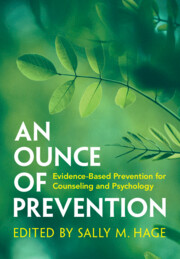Book contents
- An Ounce of Prevention
- An Ounce of Prevention
- Copyright page
- Dedication
- Contents
- Figures
- Contributors
- Acknowledgments
- Part One A Foundation in Prevention
- Part Two Prevention with Children and Youth
- Part Three Prevention with Emerging Adults
- 8 Ecological and Developmental Approaches to Reducing Substance Use and Related Harms among Emerging Adults
- 9 Building Action from Awareness Movements
- 10 Best Practices in Building Comprehensive Strategies to Prevent Sexual Violence for College-Age Students
- 11 College: The Window of Opportunity
- Part Four Across the Lifespan: Adults and Families
- Part Five Closing
- Index
- References
8 - Ecological and Developmental Approaches to Reducing Substance Use and Related Harms among Emerging Adults
from Part Three - Prevention with Emerging Adults
Published online by Cambridge University Press: 14 November 2024
- An Ounce of Prevention
- An Ounce of Prevention
- Copyright page
- Dedication
- Contents
- Figures
- Contributors
- Acknowledgments
- Part One A Foundation in Prevention
- Part Two Prevention with Children and Youth
- Part Three Prevention with Emerging Adults
- 8 Ecological and Developmental Approaches to Reducing Substance Use and Related Harms among Emerging Adults
- 9 Building Action from Awareness Movements
- 10 Best Practices in Building Comprehensive Strategies to Prevent Sexual Violence for College-Age Students
- 11 College: The Window of Opportunity
- Part Four Across the Lifespan: Adults and Families
- Part Five Closing
- Index
- References
Summary
Substance use (SU) and substance use disorders (SUDs) are prevalent public health problems among emerging adult populations. Emerging adulthood is a time when young people are growing in their independence and exploring their identities, social connections, and future opportunities. It is also a developmental period characterized by experimentation and engagement in alcohol and drug use. The aim of this book chapter is to discuss and provide examples of prevention research to address SU/SUD among emerging adults. We utilize ecodevelopmental and multicultural frameworks to discuss approaches to prevention research. Next, we describe prevention research in the following areas: risk and protective factor research and intervention development. In the area of risk and protective factor research, we will review studies testing risk and protective factors for SU/SUD among Latinx emerging adults. Finally, we also share the development of two intervention studies designed to address alcohol-related sexual assault and a cognitive-behavioral model for mild-to-moderate substance use disorder. Implications for future prevention research are also discussed.
- Type
- Chapter
- Information
- An Ounce of PreventionEvidence-Based Prevention for Counseling and Psychology, pp. 155 - 174Publisher: Cambridge University PressPrint publication year: 2024

